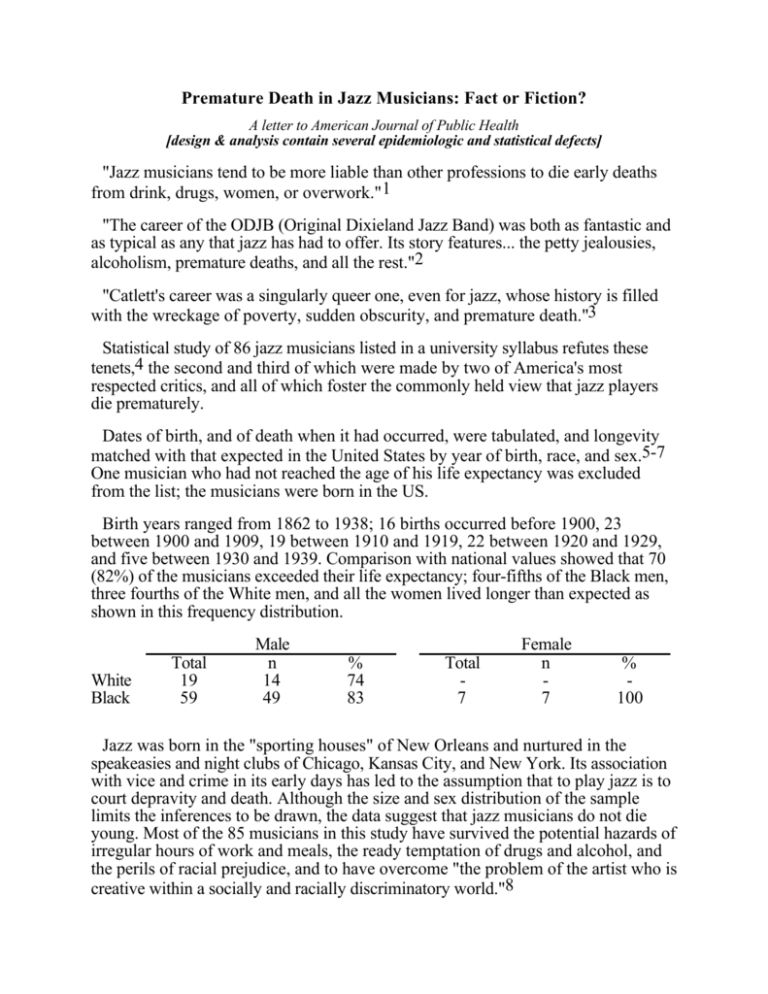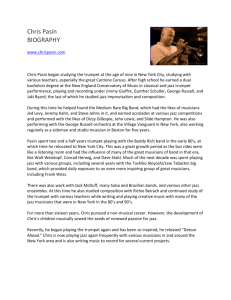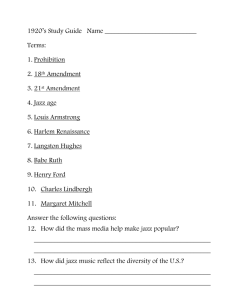Premature Death in Jazz Musicians: Fact or Fiction? "Jazz musicians
advertisement

Premature Death in Jazz Musicians: Fact or Fiction? A letter to American Journal of Public Health [design & analysis contain several epidemiologic and statistical defects] "Jazz musicians tend to be more liable than other professions to die early deaths from drink, drugs, women, or overwork."1 "The career of the ODJB (Original Dixieland Jazz Band) was both as fantastic and as typical as any that jazz has had to offer. Its story features... the petty jealousies, alcoholism, premature deaths, and all the rest."2 "Catlett's career was a singularly queer one, even for jazz, whose history is filled with the wreckage of poverty, sudden obscurity, and premature death."3 Statistical study of 86 jazz musicians listed in a university syllabus refutes these tenets,4 the second and third of which were made by two of America's most respected critics, and all of which foster the commonly held view that jazz players die prematurely. Dates of birth, and of death when it had occurred, were tabulated, and longevity matched with that expected in the United States by year of birth, race, and sex.5-7 One musician who had not reached the age of his life expectancy was excluded from the list; the musicians were born in the US. Birth years ranged from 1862 to 1938; 16 births occurred before 1900, 23 between 1900 and 1909, 19 between 1910 and 1919, 22 between 1920 and 1929, and five between 1930 and 1939. Comparison with national values showed that 70 (82%) of the musicians exceeded their life expectancy; four-fifths of the Black men, three fourths of the White men, and all the women lived longer than expected as shown in this frequency distribution. White Black Total 19 59 Male n 14 49 % 74 83 Total 7 Female n 7 % 100 Jazz was born in the "sporting houses" of New Orleans and nurtured in the speakeasies and night clubs of Chicago, Kansas City, and New York. Its association with vice and crime in its early days has led to the assumption that to play jazz is to court depravity and death. Although the size and sex distribution of the sample limits the inferences to be drawn, the data suggest that jazz musicians do not die young. Most of the 85 musicians in this study have survived the potential hazards of irregular hours of work and meals, the ready temptation of drugs and alcohol, and the perils of racial prejudice, and to have overcome "the problem of the artist who is creative within a socially and racially discriminatory world."8 Premature Death in Jazz Musicians: Fact or Fiction? • The main errors 1 To be a jazz musician, one must first survive into adulthood, so comparison should be with others who also survive to adulthood. Thus life expectancy should be calculated from adulthood, rather than birth, onwards. [the same fallacy is evident in comparisons of average age at death of bishops and priests] 2 Life expectancy is typically calculated from current mortality e.g. the life expectancy calculated for 1995 uses 1995 mortality rates only and applies them to a fictitious cohort of infants who are subjected to these (cross-sectionally derived) mortality rates as they progress from birth to death. Since mortality rates have been falling over time, the calculated life-expectancies tend to underestimate the average longevity. Thus, comparison of the longevity of those born in 1910 with the longevity projected from 1910 mortality rates will favour those born in 1910. 3 Should not have excluded survivor.. should have used a lifetable approach. 4 More than 50% can survive past the average (mean) age of death -- if distribution of age at death (longevity) has a long left tail. 50% survive past the median. See letter from Rothman in Amer J Public Health. 82(5):761, 1992 May. I thought Rothman was a bit rough on the author -- an emeritus professor (in a discipline far from epidemiology) who tried to be scholarly -- jh







